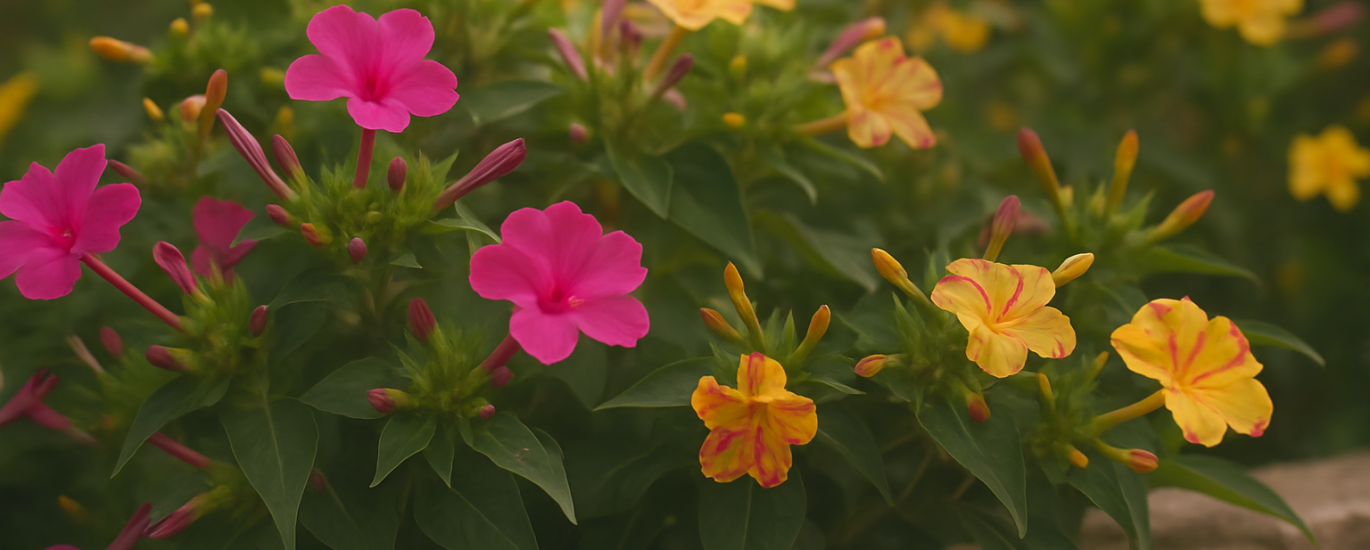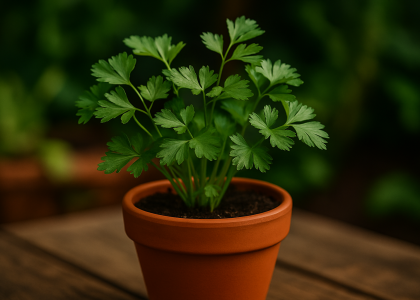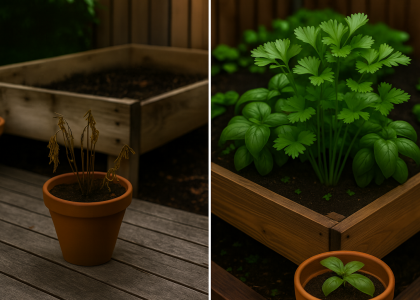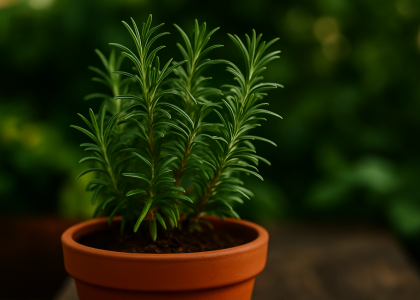Why Four O’Clocks Deserve a Comeback in Modern Gardens
What if your flowerbed could surprise you—daily?
Four O’Clock flowers (Mirabilis jalapa), named for their charming habit of blooming in the late afternoon, bring old-fashioned charm with a modern edge. From sunset fragrance to tricolor petals on a single plant, this low-maintenance wonder is now making waves among drought-tolerant garden designers, pollinator advocates, and color lovers.
A must-have in any evening garden or low-effort border, Four O’Clocks are colorful, fragrant, and full of surprises—just when the rest of the garden winds down.
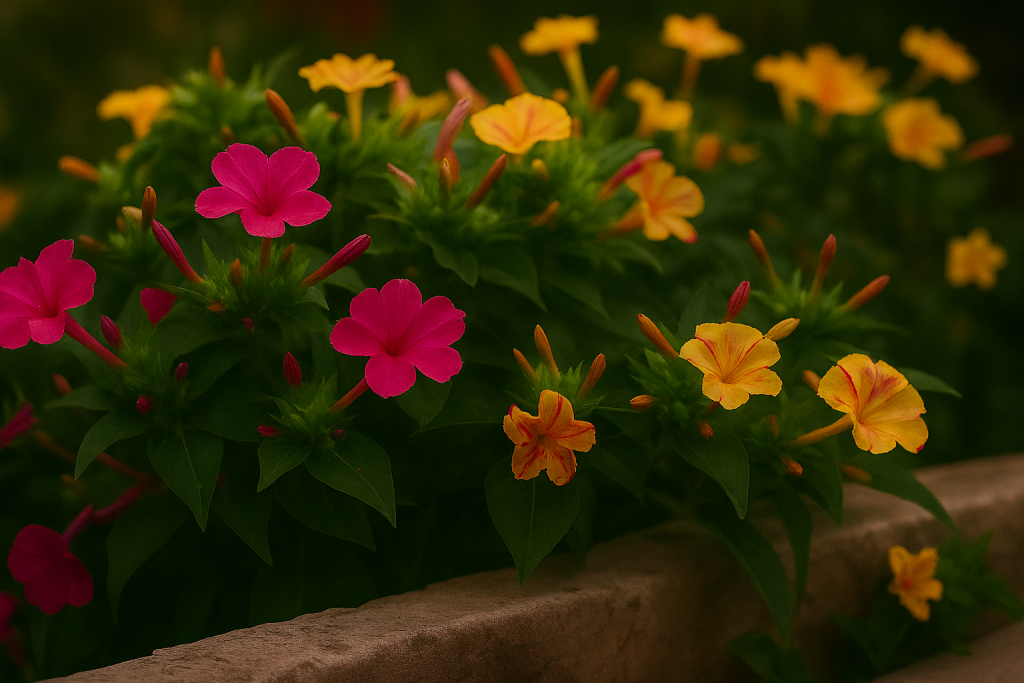
Quick Plant Profile: Four O’Clock at a Glance
| Feature | Details |
|---|---|
| Common Name | Four O’Clock, Marvel of Peru |
| Scientific Name | Mirabilis jalapa |
| Type | Tender perennial (grown as annual in cool zones) |
| USDA Zones | 7–11 (perennial), 2–6 (annual from seed/tuber) |
| Bloom Time | Mid to late afternoon until nightfall |
| Sun Needs | Full sun to light shade |
| Soil | Well-drained, tolerates poor soil |
| Fragrance | Sweet and noticeable in the evening |
| Height & Spread | 2–3 ft tall and wide |
| Toxicity | Mildly toxic if ingested (esp. tubers) |
Best Regions to Grow Four O’Clocks
US Regions
- Zone 9–11 (perennial): Southern Florida, Texas, Southern Arizona, Southern California
- Zone 7–8: Can overwinter with mulch or dig tubers in fall
- Zone 2–6: Grow as an annual, start from seed or replant tubers in spring
European Regions
- Mediterranean Europe: Spain, Italy, Southern France, Portugal – plant tubers or seeds directly outdoors
- Temperate zones (UK, Germany, Netherlands): Grow as summer annual, start indoors for early blooms
Pro Tip: Even in cooler zones, Four O’Clocks self-seed reliably—expect them to return next year, sometimes in new colors!
How to Grow and Care for Four O’Clocks
Soil & Location
- Thrives in average, well-drained soil
- Tolerates clay and sandy ground
- Choose a sunny spot for maximum blooms and scent
Light Requirements
- Needs at least 6 hours of sunlight per day
- In hot regions, some afternoon shade is beneficial
Watering
- Drought-tolerant once established
- Water deeply once a week; more during hot, dry spells
- Overwatering may rot tubers in heavy soil
Pruning & Maintenance
- No deadheading needed—blooms fall cleanly
- Can be cut back by half midsummer for fresh new growth
- Tubers may be dug and stored like dahlias in frost-prone zones
3 Smart Garden Solutions for the Four O’Clock Flower Comeback
Where Real-Life Garden Problems Meet Colorful, Low-Fuss Magic
Four O’Clocks (Mirabilis jalapa) are back in the spotlight—and for good reason. These sunset bloomers check all the right boxes for modern gardeners: drought tolerance, pollinator power, and pure joy. Here’s how to bring their underrated brilliance into your 2025 garden, whether you’re working with dry soil, curious kids, or moonlit moments.
1. Low-Maintenance Color for Dry Climates
Keywords: drought-tolerant flowering plants, low water garden flowers
As water conservation becomes a top priority, Four O’Clocks rise to the challenge. They thrive in lean soils, need very little watering once established, and still deliver a kaleidoscope of blooms night after night.
Smart Uses for Water-Wise Gardeners:
- Tuck them into gravel gardens, rockeries, and xeriscapes
- Use them to fill sun-drenched border beds where other flowers fade
- Pair with Mediterranean herbs like lavender, salvia, or agastache to create a fragrant, pollinator-rich haven
Think of Four O’Clocks as the zinnias of twilight—just as bold, just as tough, but with a night-blooming twist.
And best of all? These plants practically care for themselves. Perfect for vacation homes, weekend gardeners, and anyone craving floral impact without the daily chore list.
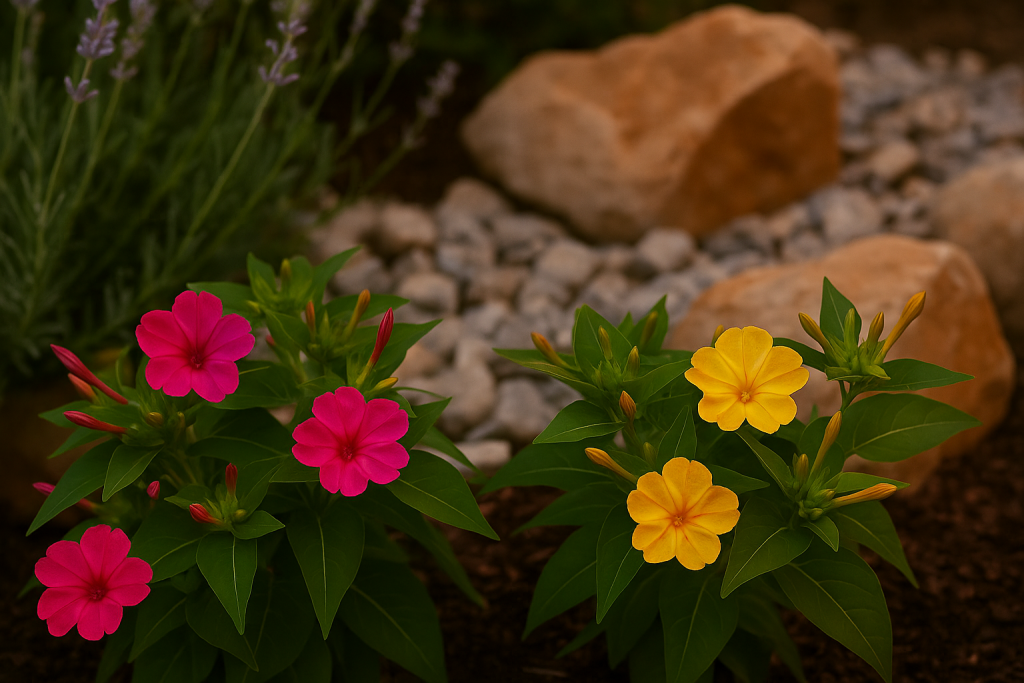
2. Twilight Pollinator Magnet
Keywords: evening blooming flowers for pollinators, night pollinator plants
When the sun goes down, most flowers close up shop—but Four O’Clocks are just getting started. Their late-afternoon blooms and intoxicating fragrance make them a beacon for nocturnal pollinators, including moths, hawk-moths, and even night bees.
How to Build an Evening Pollinator Oasis:
- Create a layered bed with moonflowers and Nicotiana to extend bloom time into the night
- Line pathways with solar lights that spotlight your Four O’Clocks after dark
- Add a shallow water dish or pollinator rock spa to support beneficial insects
Bonus Win: They’re beloved by sphinx moths—the very same pollinators that help native evening primrose and other wild night-bloomers thrive.
Whether you're aiming for pollinator support, nighttime beauty, or both, this plant becomes your garden’s evening headliner.
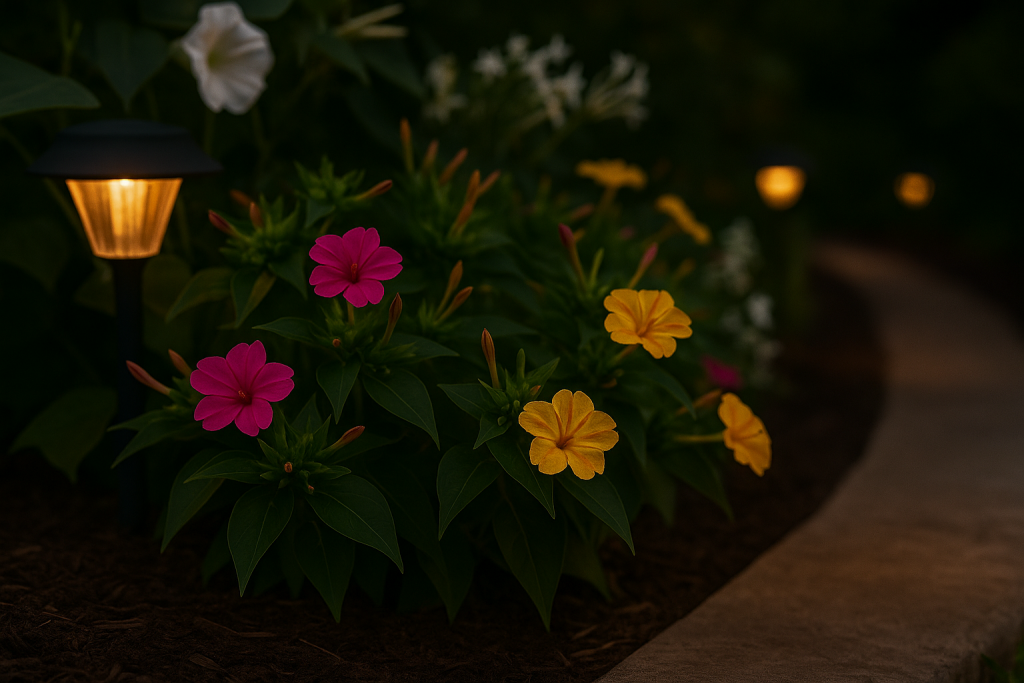
3. Garden Play for Kids & Curious Growers
Keywords: fun flowers for kids, flowers that change color
Looking to spark wonder in young gardeners or bring back your own sense of discovery? Four O’Clocks are pure backyard magic.
With blooms that shift colors, petals in different hues on a single plant, and a reliable opening window around 4 PM, they’re perfect for hands-on learning and nature play.
Creative Ideas for Garden-Based Learning & Play:
- Plant in schoolyard gardens, family garden plots, or kids' outdoor STEM zones
- Turn your garden into a living clock—track bloom times with "flower time logbooks"
- Encourage seed saving and hybrid watching—no two plants are ever quite the same!
Watch their faces light up when they discover pink, yellow, and white flowers sharing the same stem—it’s like nature painted it just for them.
Whether you're teaching photosensitivity or just enjoying the marvel of color-shifting petals, Four O’Clocks are one of the most interactive flowers a garden can offer.
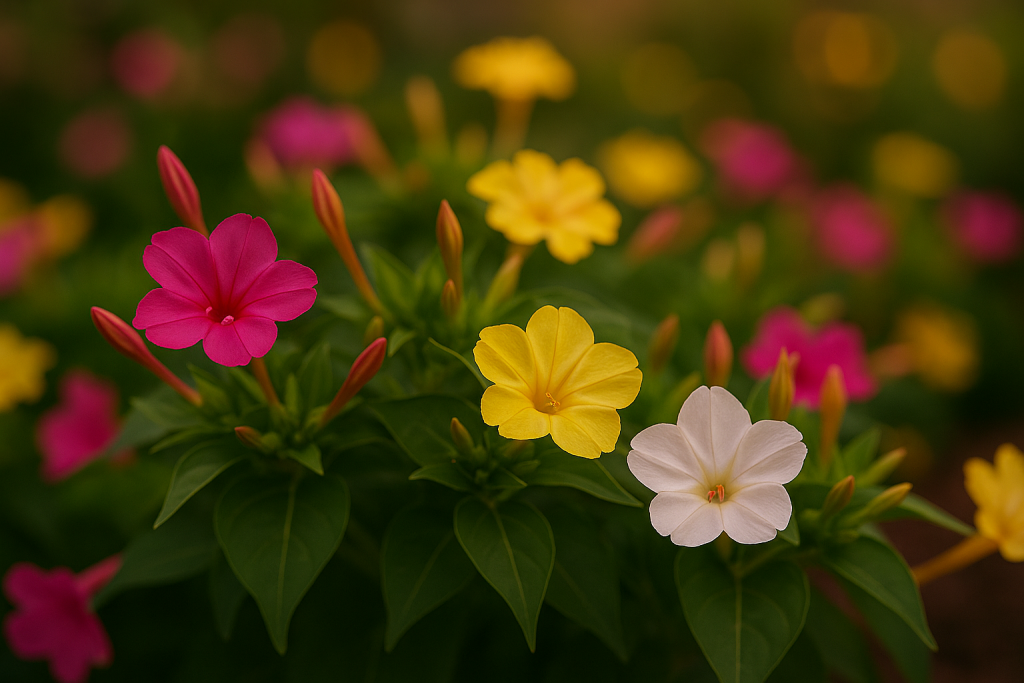
Pro Tip for All Three Solutions: Four O’Clocks are incredibly adaptable in pots and containers, making them perfect for balconies, patios, and even community gardens where space is limited but creativity is not.
Companion Planting & Design Tips
| Companion Plant | Benefit |
|---|---|
| Moonflower | Complements evening theme, climbing habit |
| Marigolds | Pest-repellent, bright daytime contrast |
| Dusty Miller | Silvery foliage, drought-tolerant combo |
| Verbena | Adds long-blooming color & attracts pollinators |
Use Four O’Clocks to bridge the color gap between late afternoon and nightfall—a beautiful, fragrant hand-off.
Grow a Little Wonder at Sundown
In a world that moves too fast, Four O’Clocks remind us to pause. As the day fades, these humble blooms awaken—bursting into color, releasing fragrance, and drawing nighttime visitors.
They don’t ask much: a bit of sun, a patch of soil, and a gardener who loves surprise. Whether you’re planting to save water, enchant the kids, or invite twilight pollinators, Mirabilis jalapa is a wildly underappreciated star.
Want to bring more magic into your garden?

